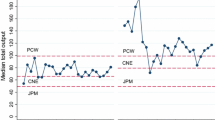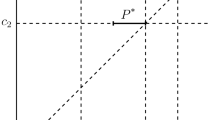Abstract
This paper analyzes imitation dynamics in Cournot oligopolies when firms imitate both rivaling firms and firms in other markets. The resulting tension between relative and absolute performance leads to a unique prediction strictly between the Nash equilibrium and perfectly competitive outcomes, which is fully characterized by a simple formula. The outcome becomes less competitive as the number of markets increases, i.e., as firms receive more information about firms in other markets. A link with relative payoff maximization is provided. An extension of the benchmark model reveals that sophisticated firms imitating across asymmetric markets converge to a related but somewhat less competitive outcome.

Similar content being viewed by others
Notes
Some empirical evidence suggests that strategic decisions are sometimes guided by observing firms in other markets. For example, Greve (1998) finds that local US radio stations imitate the choice of market position of stations serving other regions.
Ellison and Fudenberg (1993), Eshel et al. (1998), Apesteguia et al. (2007) and Bergin and Bernhardt (2009), among others, consider similar imitation rules. While focusing on IBA allows a clear exposition, one can of course think of alternative rules. For example, more optimistically biased firms may imitate the quantity with the highest maximum profit. Section 3.5 discusses such behavior and argues that it leads to results closely paralleling Alós-Ferrer’s (2004) analysis of imitation among firms with finite memory.
The “Cournot quantity” is the quantity produced by each firm in the symmetric Nash equilibrium.
Henceforth, time indexes are omitted whenever possible.
For some values of \(\mu \), convergence to an absorbing state is fast. For example, if \(\mu =1\), the process immediately enters an absorbing state from any state at which there are no ties.
When possible, the arguments of \(q^{s}(k,n)\) will be omitted in order to reduce notation.
Apesteguia et al. (2010) find such preferences to be behaviorally relevant.
While it is perhaps most natural to think of \(K(q_{i},q_{-i})\) as a simple average, it could, e.g., also be that \(K(q_{i},q_{-i})=\max _{j\in N\backslash \{i\}}\pi (q_{j},Q)\), i.e., each firm wants to maximize the distance to the runner-up.
Hedlund and Oyarzun (2014) argue that social comparison can motivate a similar approach in an environment of technology adoption.
Notice that since firms are not assumed to know the inverse demand or cost function, more sophisticated behavior, such as best responding behavior, is still unfeasible here.
While, as in the benchmark model, it can be shown that any absorbing set is an absorbing state, the argument is somewhat lengthy and is omitted for reasons of space. The proof of the main result of this section, however, explicitly shows that no non-singleton absorbing set is stochastically stable.
References
Alchian, A.A.: Uncertainty, evolution and economic theory. J. Polit. Econ. 57, 211–221 (1950)
Alós-Ferrer, C.: Cournot vs Walras in dynamic oligopolies with memory. Int. J. Ind. Org. 22, 193–217 (2004)
Alós-Ferrer, C., Ania, A.B.: The evolutionary stability of perfectly competitive behavior. Econ. Theory 26, 497–516 (2005)
Alós-Ferrer, C., Shi, F.: Imitation with asymmetric memory. Econ. Theory 49, 193–215 (2012)
Alós-Ferrer, C., Weidenholzer, S.: Contagion and efficiency. J. Econ. Theory 143, 251–274 (2008)
Alós-Ferrer, C., Ania, A., Schenk-Hoppé, K.R.: An evolutionary model of bertrand oligopoly. Games Econ. Behav. 33, 1–19 (2000)
Ania, A.: Evolutionary stability and Nash equilibrium in finite populations, with an application to price competition. J. Econ. Behav. Org. 65, 472–488 (2008)
Anwar, A.: On the co-existence of conventions. J. Econ. Theory 107, 145–155 (2002)
Apesteguia, J., Huck, S., Oechssler, J.: Imitation: theory and experimental evidence. J. Econ. Theory 136, 217–235 (2007)
Apesteguia, J., Huck, S., Oechssler, J., Weidenholzer, S.: Imitation and the evolution of Walrasian behavior: theoretically fragile but behaviorally robust. J. Econ. Theory 145, 1603–1617 (2010)
Bergin, J., Bernhardt, D.: Cooperation through imitation. Games Econ. Behav. 67, 376–388 (2009)
Ellison, G.: Basins of attraction, long-run stochastic stability, and the speed of step-by-step evolution. Rev. Econ. Stud. 67, 17–45 (2000)
Ellison, G., Fudenberg, D.: Rules of thumb for social learning. J. Polit. Econ. 101, 612–643 (1993)
Ely, J.C.: Local conventions. Adv. Theor. Econ. 2, 1–30 (2002)
Eshel, I., Samuelson, L., Shaked, A.: Altruists, egoists and hooligans in a local interaction model. Am. Econ. Rev. 88, 157–179 (1998)
Freidlin, M., Wentzell, : Random Perturbations of Dynamic Systems. Springer, New York (1984)
Gigerenzer G, Todd PM, the ABC Research Group: Simple Heuristics that Make us Smart. Oxford University Press, New York (1999)
Greve, H.: Managerial cognition and the mimetic adoption of market positions: what you see is what you do. Strateg. Manag. J. 19, 967–988 (1998)
Hedlund, J., Oyarzun, C.: Imitation in Heterogeneous Populations, working paper (2014)
Huck, S., Normann, H., Oechssler, J.: Learning in Cournot oligopoly: an experiment. Econ. J. 109, 80–95 (1999)
Huck, S., Normann, H., Oechssler, J.: Does information about competitors’ actions increase or decrease competition in experimental oligopoly markets? Int. J. Ind. Org. 18, 39–57 (2000)
Kandori, M., Mailath, G., Rob, R.: Learning, mutation and long-run equilibria in games. Econometrica 61, 29–56 (1993)
Matros, A.: Altruistic versus rational behavior in a public good game. J. Econ. Dyn. Control 36, 642–656 (2012)
Mengel, F.: Conformism and cooperation in a local interaction model. J. Evol. Econ. 19, 397–415 (2009)
Offerman, T., Potters, J., Sonnemans, J.: Imitation and belief learning in an oligopoly experiment. Rev. Econ. Stud. 69, 973–997 (2002)
Oyarzun, C., Ruf, J.: Monotone imitation. Econ. Theory 41, 411–441 (2009)
Pingle, M., Day, R.: Modes of economizing behavior: experimental evidence. J. Econ. Behav. Org. 29, 191–209 (1996)
Possajennikov, A.: Evolutionary foundations of aggregate-taking behavior. Econ. Theory 21, 921–928 (2003)
Rhee, M., Kim, Y., Han, J.: Confidence in imitation: Niche-width strategy in the UK automobile industry. Manag. Sci. 52, 501–513 (2006)
Schaffer, M.: Evolutionarily stable strategies for a finite population and a variable contest size. J. Theor. Biol. 132, 469–478 (1988)
Schaffer, M.: Are profit maximizers the best survivors? J. Econ. Behav. Org. 12, 29–45 (1989)
Schenk-Hoppé, K.R.: The evolution of Walrasian behavior in oligopolies. J. Math. Econ. 33, 35–55 (2000)
Schipper, B.: Imitators and optimizers in a Cournot oligopoly. J. Econ. Dyn. Control 33, 1981–1990 (2009)
Selten, R., Apesteguia, J.: Experimentally observed imitation and cooperation in price competition on the circle. Games Econ. Behav. 51, 171–192 (2005)
Tanaka, Y.: Long run equilibria in an asymmetric oligopoly. Econ. Theory 14, 705–715 (1999)
Tanaka, Y.: Stochastically stable states in an oligopoly with differentiated goods: equivalence of price and quantity strategies. J. Math. Econ. 34, 235–253 (2000)
Vega-Redondo, F.: The evolution of Walrasian behavior. Econometrica 65, 375–384 (1997)
Young, P.: The evolution of conventions. Econometrica 61, 57–84 (1993)
Author information
Authors and Affiliations
Corresponding author
Additional information
I thank an associate editor and two referees for very constructive feedback, and Carlos Alós-Ferrer, José Apesteguia, Antonio Morales, Joerg Oechssler, Carlos Oyarzun, Adam Sanjurjo, Luis Ubeda and Amparo Urbano, as well as seminar participants at the University of Alicante, Stockholm School of Economics, ADRES 2010 and ASSET 2010, for many helpful comments and suggestions. Financial support from the Spanish Ministry of Innovation and Science, with reference BES-2008-008040, is gratefully acknowledged.
Rights and permissions
About this article
Cite this article
Hedlund, J. Imitation in Cournot oligopolies with multiple markets. Econ Theory 60, 567–587 (2015). https://doi.org/10.1007/s00199-015-0878-7
Received:
Accepted:
Published:
Issue Date:
DOI: https://doi.org/10.1007/s00199-015-0878-7




